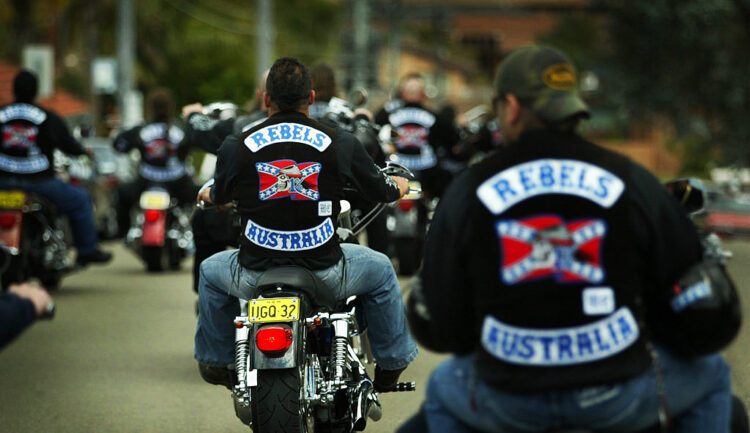The domestic crackdown on the gangs was partly caused by the public outcry following the Airport brawl. Before then, bikie elites were often derided in Australian popular culture as Instagram-obsessed “Nike bikies” — roided-up gym junkies who don’t even ride Harleys. (One leader was known as the “Bathrobe Bikie”, because he had a tendency to pose in Versace loungewear.) But if leaders are more cosmopolitan, their gangs are comprised largely of young men from Sydney’s severely disadvantaged western suburbs, who do the dirty work. The city has seen a spate of high-profile bikie attacks in the last few years, including a bitter drug distribution feud between two bikie-linked clans, the Alameddines and the Hamzys. Scores of shootings which almost wiped out the latter family entirely, and the bloodshed was met with wide condemnation — from talkback radio callers demanding swift action, to then-Prime Minister Kevin Rudd denouncing the brawl as “absolutely unacceptable”. The police promised to step up.
The Alameddines and Hamzys are fairly low-ranking clans, but infighting has plagued the big boys, too. In 2018, a former Comanchero boss, Mahmoud “Mick” Hawi — who was charged with the manslaughter of Anthony Zervas — was murdered by a friend with financial motives. (The accused man was subsequently acquitted and then murdered himself last year.) A report last year from Deakin University challenges the narrative that what drives the gangs is endless patch-on-patch warfare; they are, rather, looking for new ways to do business. “OMCGs have changed in the past 10 to 15 years,” author Professor David Bright said. “Before this, they were very much about the brotherhood and that antisocial bikie lifestyle, but now they’re inviting young members to join simply because they have a criminal history the club finds useful.” The study also found that young men looking to get into bikie gangs aren’t motivated less by being their brothers’ keeper and more by the cash that can be made.
The focus on money-making, as well as the police crackdown, has seen an exodus of senior bikie leaders, who want both to escape the law and oversee offshore operations. Estimates suggest that a third of senior leaders live outside of Australia — in places such as Dubai, Cyprus, Thailand and Turkey — although this trend has been dented in recent months by the extraditions of key figures. Mark Buddle, exiled leader of the Comanchero — and considered the most wanted man in the country — was dragged home late last year with a series of security measures worthy of a war criminal.
Bikies don’t elicit a lot of sympathy, but there’s clear evidence that they’re being over-policed. Data from the two states that provided it shows that the failed prosecution rate for members of OMCGs (outlaw motorcycle gangs) was up to four times higher than the general population. States routinely try to enact anti-association laws, which included bans on operating clubhouses and working in tattoo parlours, and jail time for consorting in public in groups larger than three. These laws are often struck down by the courts.
But it’s the “501 law” that has had the profoundest effect. Brought into effect in 2015, it gives the Immigration Minister the power to deport people born in another country if they’ve spent 12 or more months in jail. Freedom of movement laws between Australia and New Zealand, and the opportunities present in former’s organised crime scene, mean that ambitious young Kiwis travel over the Tasman to ply their trade in Sydney. The 501 law has seen many of them sent back to New Zealand. The irony of Australia effectively creating a modern penal colony isn’t lost on the Kiwis, who have been critical of the practice. New Zealand is decidedly anxious about importing Australian problems to its shores, and with good reason: the Comanchero turned the challenge presented by the 501 law into an opportunity, by opening a New Zealand chapter. It is estimated that Kiwi gang membership in total has doubled to over 8,000 since 2016. Indeed, the nation has had to do some deporting of its own, to the Pacific Islands.
Inevitably, the oceanic drug highway has blossomed as a result. Small island nations, such as Fiji and Tonga — which are in many ways beholden to the two regional leaders — have become fundamental hubs in the trade between the Americas and Australia. Bikie gangs have established chapters in many of them, often thanks to members who have been deported. A report last year by the Lowy Institute found that, in the Pacific Islands, “drug trafficking has evolved significantly with the rise of local actors in transnational criminal networks”. It blamed the deportation policies of Australia, New Zealand and the United States for “exacerbating crime and addiction within Pacific nations”.
Last month, two prominent news stories underlined the extent that the drug trade is now very much a regional issue. A record-breaking 3.2-tonne haul of cocaine, valued at £260 million, was discovered floating in bales in international waters north-east of New Zealand. Greg Williams, director of New Zealand’s National Organised Crime Group, claimed that it had to be bound for Australia — because Aussies would only take 12 months to get through the drugs, while the same amount would take Kiwis 30 years. Then there was the curious case of a group of men found clinging to an ice box off the southern coast of Western Australia. The men claimed that their boat had capsized fishing, but in the following days, both it and 365kg of cocaine had washed up on nearby beaches.
Source link : https://unherd.com/2023/03/australian-drug-kings-have-gone-global/
Author :
Publish date : 2023-03-01 03:00:00
Copyright for syndicated content belongs to the linked Source.
